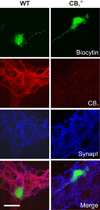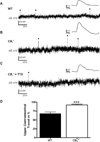Plasticity of mouse enteric synapses mediated through endocannabinoid and purinergic signaling
- PMID: 22235973
- PMCID: PMC3276688
- DOI: 10.1111/j.1365-2982.2011.01860.x
Plasticity of mouse enteric synapses mediated through endocannabinoid and purinergic signaling
Abstract
Background: The enteric nervous system (ENS) possesses extensive synaptic connections which integrate information and provide appropriate outputs to coordinate the activity of the gastrointestinal tract. The regulation of enteric synapses is not well understood. Cannabinoid (CB)(1) receptors inhibit the release of acetylcholine (ACh) in the ENS, but their role in the synapse is not understood. We tested the hypothesis that enteric CB(1) receptors provide inhibitory control of excitatory neurotransmission in the ENS.
Methods: Intracellular microelectrode recordings were obtained from mouse myenteric plexus neurons. Interganglionic fibers were stimulated with a concentric stimulating electrode to elicit synaptic events on to the recorded neuron. Differences between spontaneous and evoked fast synaptic transmission was examined within preparations from CB(1) deficient mice (CB(1)(-/-)) and wild-type (WT) littermate controls.
Key results: Cannabinoid receptors were colocalized on terminals expressing the vesicular ACh transporter and the synaptic protein synaptotagmin. A greater proportion of CB(1)(-/-) neurons received spontaneous fast excitatory postsynaptic potentials than neurons from WT preparations. The CB(1) agonist WIN55,212 depressed WT synapses without any effect on CB(1)(-/-) synapses. Synaptic activity in response to depolarization was markedly enhanced at CB(1)(-/-) synapses and after treatment with a CB(1) antagonist in WT preparations. Activity-dependent liberation of a retrograde purine messenger was demonstrated to facilitate synaptic transmission in CB(1)(-/-) mice.
Conclusions & inferences: Cannabinoid receptors inhibit transmitter release at enteric synapses and depress synaptic strength basally and in an activity-dependent manner. These actions help explain accelerated intestinal transit observed in the absence of CB(1) receptors.
© 2012 Blackwell Publishing Ltd.
Figures






Similar articles
-
Unique inhibitory synapse with particularly rich endocannabinoid signaling machinery on pyramidal neurons in basal amygdaloid nucleus.Proc Natl Acad Sci U S A. 2011 Feb 15;108(7):3059-64. doi: 10.1073/pnas.1012875108. Epub 2011 Jan 31. Proc Natl Acad Sci U S A. 2011. PMID: 21282604 Free PMC article.
-
Endocannabinoids suppress excitatory synaptic transmission to dorsal raphe serotonin neurons through the activation of presynaptic CB1 receptors.J Pharmacol Exp Ther. 2009 Oct;331(1):186-96. doi: 10.1124/jpet.109.153858. Epub 2009 Jul 10. J Pharmacol Exp Ther. 2009. PMID: 19592666 Free PMC article.
-
Cannabinoid receptor 1 signalling dampens activity and mitochondrial transport in networks of enteric neurones.Neurogastroenterol Motil. 2009 Sep;21(9):958-e77. doi: 10.1111/j.1365-2982.2009.01300.x. Epub 2009 Apr 17. Neurogastroenterol Motil. 2009. PMID: 19374636
-
Multiple mechanisms of fast excitatory synaptic transmission in the enteric nervous system.J Auton Nerv Syst. 2000 Jul 3;81(1-3):97-103. doi: 10.1016/s0165-1838(00)00130-2. J Auton Nerv Syst. 2000. PMID: 10869707 Review.
-
Endocannabinoid liberation from neurons in transsynaptic signaling.J Mol Neurosci. 2007 Sep;33(1):87-93. doi: 10.1007/s12031-007-0043-2. J Mol Neurosci. 2007. PMID: 17901551 Review.
Cited by
-
Characterisation of tau in the human and rodent enteric nervous system under physiological conditions and in tauopathy.Acta Neuropathol Commun. 2018 Jul 23;6(1):65. doi: 10.1186/s40478-018-0568-3. Acta Neuropathol Commun. 2018. PMID: 30037345 Free PMC article.
-
Endocannabinoids in the Gut.Cannabis Cannabinoid Res. 2016 Feb;1(1):67-77. doi: 10.1089/can.2016.0001. Epub 2016 Feb 24. Cannabis Cannabinoid Res. 2016. PMID: 27413788 Free PMC article.
-
The roles of purinergic signaling during gastrointestinal inflammation.Curr Opin Pharmacol. 2012 Dec;12(6):659-66. doi: 10.1016/j.coph.2012.09.011. Epub 2012 Oct 11. Curr Opin Pharmacol. 2012. PMID: 23063457 Free PMC article. Review.
-
The purinergic neurotransmitter revisited: a single substance or multiple players?Pharmacol Ther. 2014 Nov;144(2):162-91. doi: 10.1016/j.pharmthera.2014.05.012. Epub 2014 Jun 2. Pharmacol Ther. 2014. PMID: 24887688 Free PMC article. Review.
-
Intestinal lipid-derived signals that sense dietary fat.J Clin Invest. 2015 Mar 2;125(3):891-8. doi: 10.1172/JCI76302. Epub 2015 Feb 2. J Clin Invest. 2015. PMID: 25642767 Free PMC article. Review.
References
-
- Furness JB. The enteric nervous system. Malden, Mass: Blackwell Pub; 2006.
-
- Galligan JJ, North RA. Pharmacology and function of nicotinic acetylcholine and P2X receptors in the enteric nervous system. Neurogastroenterol Motil. 2004;16 Suppl 1:64–70. - PubMed
-
- Lomax AE, Sharkey KA, Furness JB. The participation of the sympathetic innervation of the gastrointestinal tract in disease states. Neurogastroenterol Motil. 2010;22:7–18. - PubMed
-
- Wilson RI, Nicoll RA. Endogenous cannabinoids mediate retrograde signalling at hippocampal synapses. Nature. 2001;410:588–592. - PubMed
-
- Kreitzer AC, Regehr WG. Retrograde inhibition of presynaptic calcium influx by endogenous cannabinoids at excitatory synapses onto Purkinje cells. Neuron. 2001;29:717–727. - PubMed
Publication types
MeSH terms
Substances
Grants and funding
LinkOut - more resources
Full Text Sources

